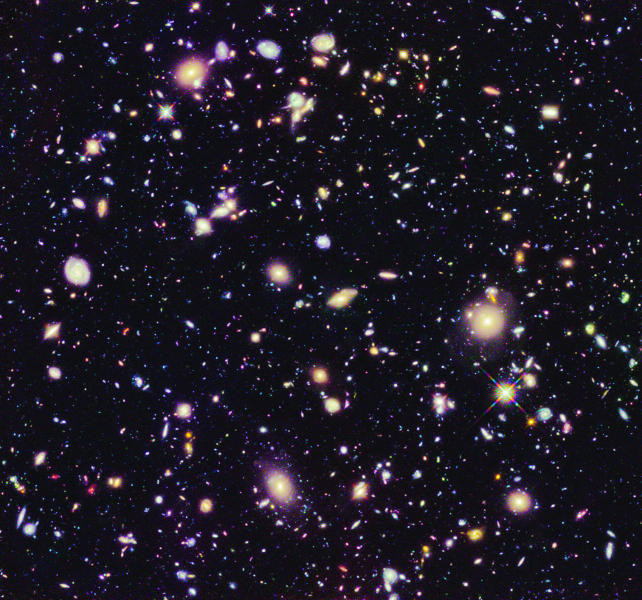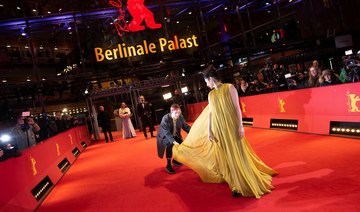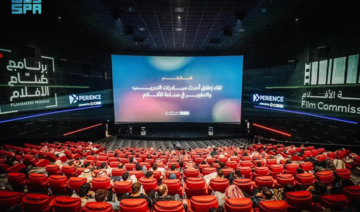WASHINGTON: The Hubble Space Telescope is giving scientists a look at the oldest galaxies ever seen, dating back some 13.3 billion years — providing a glimpse into how the cosmos must have looked right after the Big Bang.
NASA scientists announced Wednesday that Hubble has uncovered seven never-before-seen primitive galaxies dating back to when the universe was less than four percent of its current age.
These archaeological images from Hubble were gleaned from an intensively studied patch of sky known as the Ultra Deep Field (UDF).
A team of astronomers led by Richard Ellis of the California Institute of Technology in Pasadena, California used Hubble’s Wide Field Camera 3 (WFC 3) to peer deeper into space than any previous Hubble observation.
Hubble scientists said the most ancient of the seven new galaxies came into being about 13.3 billion years ago — some 380 million years after the Big Bang.
With this newest discovery, scientists nudge even a little closer to the very origins of the universe.
“Looking at these galaxies allows us to learn many, many things about the universe after the Big Bang — about our origins,” said Abraham Loeb, chairman of the Astronomy Department at Harvard University.
“For instance, we discovered that the galaxies then were 1,000 times denser than the galaxies today,” he said.
“These pictures are like the first ultrasound of an infant. It’s the oldest archaeology material on the universe,” said Loeb.
He expressed hope that Hubble may be able to plumb the depths of space for even older galaxies, perhaps nearly as old as the universe.
“To find the first galaxies we will have to look further, but there is less light, the galaxies are smaller,” Loeb told reporters.
The never-seen-before galaxies are key to interpreting the development of the first stars and the formation of the first galaxies that later evolved into the elliptical galaxies like our own Milky Way that now populate the universe, the space agency said.
One major goal of the program is to determine how rapidly the number of galaxies increases over time in the early universe. This measure is the key evidence for how quickly galaxies build up their constituent stars.
Hubble has transformed the field of astronomy since it was first launched in 1990.
Ellis said Hubble continues to make breakthroughs in space research, thanks to the sheer power and precision of the oft-rehabbed space telescope.
Hubble underwent repair during a shuttle mission in 2010 that left it with a new camera and spectrograph as well as fixed and spruced up scientific instruments.
“For the first time in 23 years we could use Hubble full tilt,” Ellis said.
“Our study has taken the subject forward in two ways,” Ellis explained during a telephone press conference.
“First, we have used Hubble to make longer exposures. The added depth is essential to reliably probe the early period of cosmic history,” he said.
“Second, we have used Hubble’s available color filters very effectively to more precisely measure galaxy distances,” Ellis added.
First launched in 1990, the telescope was repaired and upgraded in 1993, 1997, 1999, 2002, 2008 and 2010. The final upgrade extended the life of Hubble another five years, through 2015.
Hubble telescope yields images of early galaxies
Hubble telescope yields images of early galaxies

Arab designers steal the spotlight in Cannes

DUBAI: As the curtain rose on the 77th edition of the Cannes Film Festival, Arab designers once again stole the spotlight in the glamorous French Riviera setting.
Stars from around the globe are descending upon Cannes for the much-awaited 10-day cinematic celebration. The festival kicked off with the premiere of the film “The Second Act.”
Shanina Shaik, the Australian-born model of Saudi, Pakistani, and Lithuanian descent, graced the opening night red carpet in a head-turning scarlet dress by Lebanese couturier Zuhair Murad. Her strapless gown, featuring a sweetheart neckline and a dramatic overskirt, was from the designer’s ready-to-wear Fall 2024 collection.
Shaik was not the only star on the red carpet championing an Arab designer.
US German model and TV host Heidi Klum stunned on the red carpet in a bold red gown by Lebanese designer Saiid Kobeisy. The dress gathered at the waist, revealing one leg, with silk fabric draping around her.
Meanwhile, US actress Jane Fonda donned a black jumpsuit adorned with crystal embroidery from Lebanese designer Elie Saab’s Fall 2019 collection. Completing her look, she opted for a leopard-print overcoat.
“The Second Act” is a French comedy starring Lea Seydoux, Vincent Lindon, Louis Garrel and Raphaël Quenard. They play squabbling actors filming a movie directed by artificial intelligence.
The festival’s first lengthy standing ovation, though, went to Streep, who was awarded an honorary Palme d’Or during Tuesday’s opening ceremony. After Juliette Binoche introduced her, Streep shook her head, fanned herself and danced while the crowd thunderously cheered.
“I’m just so grateful that you haven’t gotten sick of my face and you haven’t gotten off of the train,” said Streep, who soon thereafter declared Cannes officially open with Binoche.
What is the celebrity ‘blockout’ over the war in Gaza?

- For the blockout, users put a block on seeing any and all content from the accounts of certain celebrities on social media platforms
NEW YORK: Some social media users are calling out celebrities for what they say is inaction in the face of a humanitarian crisis in Gaza — and they’ve taken to a “blockout” to pressure the stars to take a stand.
For the blockout, users put a block on seeing any and all content from the accounts of certain celebrities on social media platforms including X, TikTok and Instagram. Some have posted about the celebrities they’ve blocked, using a hashtag such as #blockout, #blockout2024, or #celebrityblockout, while others have shared posts from users lambasting attendees of high-glamor events like the Met Gala and contrasting it with the situation in Gaza.
Blockout participants say it’s a protest because the celebrities either haven’t spoken up or haven’t said enough against Israel’s actions in Gaza during its war with Hamas. Since the war erupted Oct. 7 with Hamas’ deadly attacks, Israel’s military has killed more than 35,000 people in Gaza, according to Gaza’s Health Ministry, which doesn’t distinguish between civilians and combatants.
How does the blockout work?
On social media platforms, users see content from people they follow, as well as from those chosen for them by algorithms. In both instances, users can select options to mute or block a person or account.
Blocking the accounts of celebrities or influencers means not seeing any of the content they produce on social media — no posts, no photos or videos, no collaborations with sponsors. The number of people interacting with content brings in money, so the blocks are meant to affect views, engagement and — ultimately — paychecks.
The blockout also is meant to target celebrities’ brands by taking eyeballs and attention away from their content.
Who is being blocked?
There is no single organized list of celebrities being blocked. Some users are offering celebrity suggestions, while others are deciding on their own. Celebrities in the US and beyond have been named in the blockout.
Blocking is up to each social media user. And every celebrity, influencer or content creator must be blocked individually on each platform.
How did the blockout start?
Protests around the Israel-Hamas war have grown, with encampments on college campuses around the country. Amid those movements, attention to what celebrities and influencers were, or weren’t, saying got a boost after the Met Gala last week.
The annual party draws a host of famous faces from the worlds of fashion, movies, music, sports and more. It’s known for its over-the-top arrivals carpet and the elaborate outfits celebrities wear. This year, the gala was circled by protesters for much of the evening.
Social media was flooded with images from the star-studded event. Around the same time, images circulated as Israel launched a military operation in the southern Gaza city of Rafah. That led to some users calling out the contrast between the gala’s celebrity opulence and the situation in Gaza — using images from both — and condemning celebrities for not using their platforms to speak up for those who are suffering.
Will the blockout be effective?
The effectiveness and staying power of the blockade are yet to be seen, said Beth Fossen, assistant professor of marketing at Indiana University. It might depend on the celebrity and what they’re known for — a famous person whose “brand” is tied to humanitarian causes may be more affected than one known primarily for talent, she added.
“If your identity is really tied to promoting something that is key to the boycotting, then this could potentially have really serious consequences for you,” Fossen said. “There might be some influencers that gain their fame by sort of promoting peace and then they’re being silent on this issue — followers may not forgive them.”
Is there blockout backlash?
There has been criticism of the blockout, with some saying the focus on celebrities takes attention away from what’s happening on the ground in Gaza. Others question what the parameters are for judging whether someone should be blocked — and what would constitute a well-known person speaking out or doing enough.
Couturier Gaurav Gupta on the Met Gala, dressing Beyonce and his Arab clients

- Gaurav Gupta flew to Dubai to showcase his latest collection just before he made his Met Gala debut by dressing actress Mindy Kaling
- ‘We have many Arab brides coming to us for their wedding dresses,’ he told Arab News
DUBAI: Indian couturier Gaurav Gupta is no stranger to the limelight. Over the past two years, his clothes have become regular sightings at the Oscars, Grammys and the Cannes Film Festival. His celebrity client list gets longer by the season, especially since his debut on the Paris Haute Couture Week calendar in January 2023.
Last year, he was in the news globally for dressing Beyonce not once but three times during her world tour and this week he made his Met Gala debut by dressing Hollywood’s Mindy Kaling at the coveted event in New York. Arab News spoke to the designer during a recent visit to Dubai, where he was exhibiting select pieces from his Spring/Summer 2024 couture collection.
“I don’t have the entire collection here, many of the pieces are still with celebrities in (Los Angeles),” laughed Gupta. The collection, titled “Arohanam,” embodies his tryst with sculptural garments and sees him experiment with complex garment construction techniques.
“We’ve worked with new techniques like the reptilian cage embroidery with the bugle beads on some of the clothes. It was also the first time we’ve done metal casting – and there are snakes on a metal breastplate,” he explained.
“We’ve had clients from all over the world, including the Middle East,” the couturier said, adding that bridalwear is of particular interest to clients in the Gulf.
“We have many Arab brides coming to us for their wedding dresses, so that’s why I brought the white gown that closed the Paris show,” he noted.
As he approaches the two-decade mark of his brand, New Delhi-raised Gupta has much to commemorate. He is the third Indian designer to be a regular on the Paris Haute Couture Week Calendar and his international acclaim is skyrocketing.
In April, US icon Mariah Carey wore a crystal gown by the designer during a performance in Las Vegas, Shakira recently sported a gown by the designer in a magazine shoot and superstar Beyonce showcased three of his designs during her “Renaissance” tour — a custom crystal bodysuit, a neon green sari-style gown, and a crystal-encrusted gown that took 700 hours to create.
“Every moment we’ve shared with her has been iconic, they’re all so unique and are almost historic. Interestingly, the neon green sari wasn’t custom-made for her, it was from our ‘Hiranyagarbha’ collection. It was selected …and was sized for her.”
Did he envision this when he embarked on his journey all those years ago?
“I always felt that something significant would happen and now it’s all unfolding at once. I’m in that overwhelming swirl of things right now,” he said.
British Lebanese actress Razane Jammal named Cartier ambassador

DUBAI: British Lebanese actress Razane Jammal has been named Cartier’s newest brand ambassador.
“It is my absolute honor to be joining the Cartier family,” the actress, famous for her roles in the Netflix series “The Sandman” and “Paranormal,” said in a statement. “I look forward to work with a Maison known for its timelessness and iconicity.”
Jammal – who also made headlines for her role in the show “Al-Thaman” – took to Instagram to share a series of images from a shoot with the French luxury label.
In one ensemble, she wore a black suit, complemented by understated gold jewelry, including a necklace, a watch, a bracelet, a ring and earrings.
In another look, she was adorned in a white blazer, accentuating with dangling diamond earrings and a coordinating necklace.
This is not the first time Jammal has worked with Cartier.
In March, she starred in the brand’s Ramadan campaign alongside Saudi athlete Husein Alireza, Egyptian Montenegrin model and actress Tara Emad, Tunisian actor Dhaffer L’Abidine and Emirati host Anas Bukhash.
In March 2023, Jammal walked the runway at a Cartier event in Dubai. She wore a black form-fitting dress with a plunging neckline, a thigh-high slit from the center and padded shoulders.
She walked alongside a long list of celebrities from the Arab world including Saudi actress and filmmaker Fatima Al-Banawi, Egyptian veteran star Yusra, Egyptian Tunisian actress Hend Sabri, French Algerian filmmaker Farida Khelfa, Somali model Rawdah Mohamed, Emad, L’Abidine, and Bukhash.
In January this year, Jammal was also named the brand ambassador for French luxury label Dior’s beauty line Dior Beauty.
“It was such an incredible experience to represent the iconic fashion house of @dior. It is a privilege to be able to represent my culture within a brand with a strong history of empowering women,” she wrote to her Instagram followers at the time. “I’m grateful to see my Dior family grow and to be aligned with exceptional women from both sides of the pond. Thank you for your trust in me.”
In October 2022, she was named the Middle East’s ambassador for Dior, the fashion house.
Saudi Film Commission takes charge of cinema sector

- First phase includes regulating licensing for the operation of permanent, temporary and special cinemas
- CEO Abdullah Al-Qahtani: The Film Commission will undertake a comprehensive review of all procedures related to the cinematic sector
JEDDAH: Saudi Arabia’s Film Commission has announced it will now have oversight over the cinema sector, which will no longer fall under the jurisdiction of the General Authority of Media Regulation.
The Council of Ministers had ordered the change, which has now been implemented after the completion of the required regulations, the Saudi Press Agency reported on Monday.
The first phase includes regulating licensing for the operation of permanent, temporary and special cinemas, as well as the production, distribution and import of movies, videos and television programs.
Abdullah Al-Qahtani, the commission’s CEO, said: “The Film Commission will undertake a comprehensive review of all procedures related to the cinematic sector with the aim of their development and enhancement.
“Key improvements will focus on enhancing the customer experience by streamlining and optimizing the processes required for all activities in the cinematic sector. This will involve reviewing the licensing requirements for the film sector, as well as simplifying the licensing process and application for related services.”
The commission posted on X: “The film and cinema sector jurisdiction has been transferred from the General Authority for Media Regulation to the Film Commission. This move, facilitated by continuous cooperation and support between the two bodies, underscores the commission’s ongoing commitment to developing and improving the sector.”
The commission’s board has approved a reduction in fees for cinema licenses. It has also waived operational license fees for three years until 2027, covering permanent, temporary, and special cinema halls. Applications for licenses can now be made through the unified electronic platform Abde’a.













